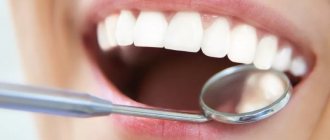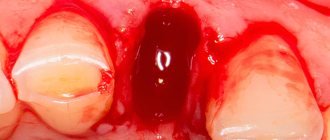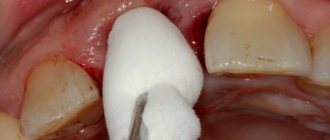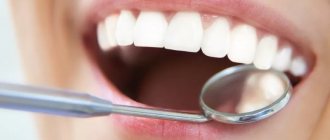How long does it take for gums to heal after tooth extraction?
Tooth extraction can be emergency or planned, but in each case healing occurs the same way.
Extraction of the organ is carried out when it is not possible to preserve the crown, in case of severe inflammation, or in advanced periodontal disease. The operation is performed under anesthesia, so there is no pain during removal. Unpleasant symptoms appear after the end of the dentist’s visit. The gums in the area of the removed organ hurt, but normally this goes away after seven days.
When the gums still hurt seven days after the tooth extraction is completed, and the inflammation does not subside for a long time, this indicates a complication. The most common consequences of organ extraction are alveolitis, bleeding, fracture, and injury to the socket.
How many days does it take for the socket and gums to heal?
During a complex operation, the dentist may damage the jaw or push the tooth root into the maxillary sinus. If you do not seek help from a dentist for a long time with such complications, even more terrible conditions appear - gumboil, cyst, osteomyelitis.
Complete healing of the gums after tooth extraction occurs within several weeks. All this time, the mucous membrane hurts a little, but is simply anesthetized with local drugs.
The healing time of the hole is personal for each patient. Recovery takes a long time if care recommendations are not followed. The gums after tooth extraction do not heal even after a couple of weeks, if an infection was introduced during the operation or after the end.
The gum heals in 14 days, and complete restoration of the socket occurs in six months.
What therapy is possible for dry socket syndrome?
Before treatment, the doctor must send the patient for an x-ray. It will reveal whether there are tooth fragments left in the hole. Then anesthesia is given, because the pathological process is accompanied by serious pain.
Table. How is dry socket syndrome treated?
| Treatment stage | How it goes | Notes |
| Cleaning the hole | The fragments and leftover food are removed, the wound is washed with an antiseptic. | Hydrogen peroxide or Furacilin can be used |
| Curettage | This is what they call scraping the inner walls of the socket. | The process is unpleasant, but due to anesthesia it does not cause serious pain |
| Inspection and reprocessing | And antiseptics are used again | This may be a solution of potassium permanganate |
| Drying the hole | Occurs using a special tool | Then anesthesin is poured into the hole |
If it is a serous inflammation, the doctor may apply an iodoform dressing to the wound.
Iodoform dressing for the treatment of post-extraction sockets
In case of a purulent inflammatory process, the bandages need to be changed daily until the patient feels better. In most cases, treatment is accompanied by antibiotics.
Why does the hole take a long time to heal?
Epithelization of the gums after the operation begins after a couple of days, and a white coating appears on it. Now it doesn’t hurt so much anymore, and there are no signs of inflammation. At this time, it is better not to touch the mucous membrane, but just continue to properly take care of the hole. It may not heal for a long time due to the patient’s personal quirks, at a time when there are diseases of the circulatory system or chronic inflammatory processes in the body.
If your gums hurt very badly after seven days, this is possible:
- Dry socket or alveolitis - this complication often appears when the rules for organ removal are not followed, while part of the crown or root remains in the socket. Under such conditions, the blood clot, which should protect against infection, falls out. This complication much more often begins on the 5th day after the end of the operation. Common symptoms are gum discoloration, unpleasant odor, halitosis, soreness, slight bleeding;
- Chronic bleeding - this complication is observed in people with hypertension and in the case of blood diseases. This may result in alveolitis. Before sending the patient home, the dentist stops the bleeding and places a hemostatic sponge on the hole;
- A fracture or dislocation of the lower jaw is a rare complication that occurs more often during the removal of a wisdom tooth; the risk increases if there is a cystic formation or acute inflammatory process in the root area;
- Perforation of the maxillary sinus is possible as a result of complex removal of chewing teeth in the upper jaw.
If the hole hurts for a long time, and it does not go away after seven days, you should immediately consult a doctor. It is forbidden to cope with complications that appeared during the removal on your own. Apart from this, there is no way to prevent them, so first aid is provided immediately after the procedure is completed.
Complications due to improper care, which slow down gum healing, can be prevented on your own.
Variants of manifestation of dry socket syndrome
Dry socket can manifest itself in different ways. It is very important to notice the pathology in time and consult a dentist.
Options for the manifestation of a dry socket:
- the serous nature of the inflammatory process - the cavity is open, and there are food debris and blood clots in it, the removal area hurts all the time;
- chronic inflammation with the release of pus, granules form along the entire perimeter of the hole, the gums swell;
- purulent-necrotic inflammation - inflamed, very swollen gums, an opening with a gray, dirty coating and dead tissue.
Suppuration of the socket
The last variant of the syndrome is considered the most dangerous. The pain is such that it radiates even to the ear and temple, and the person’s temperature almost immediately rises. Therapy in this case should only be surgical.
Pus in the hole
What to do after the extraction is complete
It is possible to realize that the hole is healing correctly on the 3rd day. The gums hurt moderately, and a white coating appears on it. It is extremely important not to remove it, since it is new epithelium. After 2 weeks, the onion should be completely covered with granulation tissue. After a month, bone tissue begins to regenerate in the entire socket. After 50 days, bone tissue fills the entire hole. And only after five to six months the hole is completely healed and does not differ from other bone tissue.
The gums will recover faster after tooth extraction is completed if you follow easy recommendations.
In the first days after surgery, minor bleeding may occur. Under such conditions, you need to take a small piece of cotton wool or gauze, soak it in hydrogen peroxide, and apply it to the hole. It is much better to go to the pharmacy immediately after removal and buy a hemostatic sponge. A small piece must be applied to the hole; it will dissolve on its own.
How does the regeneration process proceed after extraction of the “eight”
The socket of an extracted wisdom tooth is always deep. This is due to the structural features of the “eights” - they have tortuous and long roots, which cannot be extracted from the gum tissue atraumatically. Blood flows from the wound for some time. This is due to the rupture of local microvessels. Then she curls up. Then a dense blood clot forms. It is needed to protect tissues from infection.
After the operation, the doctor applies a sterile gauze swab to the hole. To fix it, the patient must close his jaws. This helps stop bleeding as quickly as possible. You need to keep the tampon in place for as long as your doctor tells you. Under no circumstances should you spit it out at the first opportunity.
In the first two days, the clot filling the hole has a rich burgundy color. Under no circumstances should you touch it, let alone try to remove it. It serves as a barrier that prevents germs, bacteria and food debris from entering an unhealed wound.
Starting from the second or third day, the appearance of the clot changes. A light coating forms on its surface. Many people get scared because they think they are releasing pus. There is no need to worry - this is a normal process. The change in the shade of the socket is associated with the formation of new protective epithelial tissue, the basis of which is fibrin protein.
Gradually, the clot dissolves on its own and disappears. A healthy pink mucous membrane is found underneath. This indicates that regeneration was completed successfully.
Do not rinse your mouth for the first 24 hours.
It is necessary to avoid warm foods and drinks, and not to take alcohol or blood thinners. It is possible to numb the wound with drugs such as Nimesil, Ibuprofen, Paracetamol. While brushing your teeth, you must avoid moving the bristles near the removed organ. If bleeding starts unexpectedly after a couple of days, you should immediately go to the doctor. This also applies to those cases when the pain is not relieved by simple analgesic and anti-inflammatory drugs.
On the third day, it is already possible to start rinsing the oral cavity with warm antiseptic solutions and herbal decoctions. This will speed up the healing of the hole and prevent inflammation and infection of the wound. For a couple more days you need to refrain from heat, sports, saunas, baths.
Some medications can have the opposite effect, leading to bleeding, so the medication must be coordinated with the dentist. Before removing the doctor, it is imperative to give a warning about concomitant and previous diseases. Tooth extraction has contraindications, and if they are missed, complications cannot be avoided.
When to see a dentist
A visit to the doctor should not be delayed in the following cases:
- Initially or after a couple of days, a blood clot falls out;
- A purulent lump appears in the area of the hole;
- The pain does not go away for a long time and inflammation appears;
- The entire jaw begins to ache, radiating to the temple and eye areas;
- There is a constant iron taste of blood in the mouth;
- Pain appears in the area of the adjacent tooth;
- Within 5 days the gums are not covered with white plaque.
If you are worried about your teeth, you will be helped at the Doctor-RAF Dental Clinic (Almaty, Muratbayev St., 101). Our highly qualified specialists will help you solve all your dental problems.
During the operation, a neighboring organ may be damaged. This will manifest itself as symptoms of pain, and perhaps the tooth will begin to loosen.
Complex removal will require additional care and the use of bactericidal drugs, but only those prescribed by the dentist. Self-prescribing antibiotics is prohibited. An exception would be local gels and ointments, which are available without a prescription and have an anti-inflammatory effect.
8 reasons why the hole does not heal after tooth extraction, ways to speed it up.
After tooth extraction, it seems that the worst is over. However, this is a surgical operation that does not exclude the possibility of complications, especially if you do not follow the doctor’s recommendations. What to do when the hole does not heal?
When you urgently need medical help
The reason to visit the dentist again is intense throbbing pain after extraction, swelling of the cheek, and the appearance of a specific (unpleasant) odor from the mouth. All these symptoms indicate the development of inflammation, which requires immediate correction. You should also not postpone your visit to the dental clinic if:
- strong painful pulsation persists for more than two days;
- accumulations of purulent masses appeared;
- pain radiates to the ear, chin, temporal area, bridge of the nose, forehead;
- the cheek is very swollen, it is impossible to touch it, since tactile contact increases the pain;
- body temperature has increased and remains high for more than one day;
- there is no blood clot on the alveolus, which should form in the next few hours after extraction;
- weakness appeared, performance after the operation decreased sharply, and the situation did not improve even a few days after the dental intervention.
You must not allow the infection to spread in your mouth. Attentive attention to your own well-being is the key to successful rehabilitation and rapid healing of the wound surface. By following the doctor’s prescriptions, you can greatly increase the chances of successful rehabilitation after extraction of a molar.
Healing process
The stages of wound healing are as follows:
- The first day: the hole fills with blood, which turns into a clot due to coagulation. It becomes the basis for bone formation in place of the void, and also protects against infection.
- 3-4 days: the clot is replaced by granulation tissue. By this time, the severity of pain decreases, and sometimes the area of surgery stops hurting completely.
- Week: a clot remains inside the socket, but most of it has already been replaced by granulation tissue.
- Two weeks: the wound is filled with granulation tissue, turning into bone along the edges and bottom.
- 2-3 months: the hole completely turns into bone.
In order for recovery to occur correctly, you must follow all the doctor’s recommendations.
How is dry socket treated in severe cases of pathology?
If complications arise, the therapy will be slightly different. And complications most often occur when the patient does not immediately contact the dentist.
A severe form of dry socket syndrome is treated as follows.
- Why do my gums hurt after tooth extraction?
- The cavity is treated and a swab moistened with special antibiotics is inserted into it. Usually, drugs that quickly relieve inflammation are added to this remedy.
- Next, an antistatic blockade is carried out.
- To clean the upper part of the wound from dead tissue, proteolytic agents are used.
- This is followed by blocking the nerve with lidocaine.
- Warm rinses are carried out with preparations such as potassium permanganate.
Potassium permanganate solution
To this list are added those procedures that the doctor uses for uncomplicated forms of dry socket syndrome. In general, the healing process will take at least a week. But if a wisdom tooth is pulled out, the recovery period may be delayed. After two, maximum two and a half weeks, the situation should normalize - granulation tissue will begin to form inside the walls of the socket. The pain will decrease, the swelling will subside, and the gums will turn pink. The first epithelial layer will begin to form.
Granulation tissue in the socket
Why doesn't the hole heal?
The timing of wound healing is an individual question. It is determined by several factors - the traumatic nature of the removal, the presence of postoperative sutures, and the age of the patient. It is believed that partial epithelization takes about 2 weeks, complete - up to two months. These deadlines may increase for the following reasons:
- The bone was severely damaged. This happens, for example, during a complex extraction, when the tissue around the tooth has to be cut out with a drill.
- The clot has fallen out, so there is no basis for the formation of granulation tissue.
- Due to the doctor's fault, bone fragments remained in the wound.
- The patient ignores the recommendations received. The most common mistake is rinsing out the clot, after which an infection from the oral cavity gets into the wound.
- The mucous membrane around the wound is mobile, and no stitches were applied.
- Carious remains entered the cavity and inflammation began.
- The surgeon did not take into account individual characteristics. For example, with arterial hypertension, heavy bleeding begins, so drugs that lower blood pressure are additionally prescribed.
- Old age of the patient.
Ways to speed up healing
The best thing a patient can do to speed up epithelialization is to create conditions in the oral cavity that are close to sterile. To do this, you must follow some rules:
- Squeeze the cotton swab applied after surgery tightly with your teeth for 15-20 minutes.
- Do not eat for 3 hours so as not to interfere with the clot formation process.
- In the first days, do not smoke, give up alcohol and solid food.
- Avoid heavy physical activity, temperature effects (hot drinks and dishes, trips to the bathhouse, sauna).
- Do not chew on the injured side for two days.
- Avoid rinsing and use chlorhexidine baths instead.
- Take prescribed medications - for example, antibiotics, which are prescribed after a complex removal, in the presence of purulent processes.
- After consulting with your doctor, use Solcoseryl, a gel that helps accelerate epithelization.
It is important to remember that the area where the deletion took place is a very vulnerable place. The mouth is home to a large number of opportunistic microorganisms, which, in the presence of a source of bleeding, become pathogenic, triggering the inflammatory process. To perform the operation, you should choose an experienced surgeon and strictly follow his recommendations after the procedure.
How to detect pathology
If you examine the hole itself, you can find a yellowish or slightly greenish coating. It is possible that there will be a rotting clot inside this cavity. There are situations when even exposed bone tissue is noticeable. At the same time, a repulsive putrid odor comes from the person’s mouth.
- Ear hurts after wisdom tooth removal
Greenish coating
The process of decay and the accompanying inflammatory process lead to intoxication (poisoning) of the patient’s body.
Therefore, the symptoms of dry socket syndrome can also be considered:
- weakness, lethargy, fatigue;
- deterioration of health;
- enlarged lymph nodes in the neck and, most likely, under the jaw;
- increase in body temperature.
Temperature rises, lymph nodes enlarge
A dry socket also leads to damage to the gums, and the cheek may become swollen. After about two days, pain will appear, the pain can spread even across the face, and also radiate to the ear. If this happens after extraction of a molar tooth in the lower jaw, the patient may well experience difficulty eating.
Cheek swelling
Severe pain may radiate to the ear










